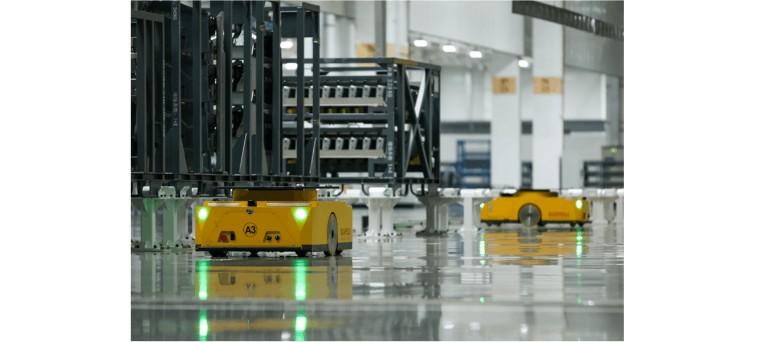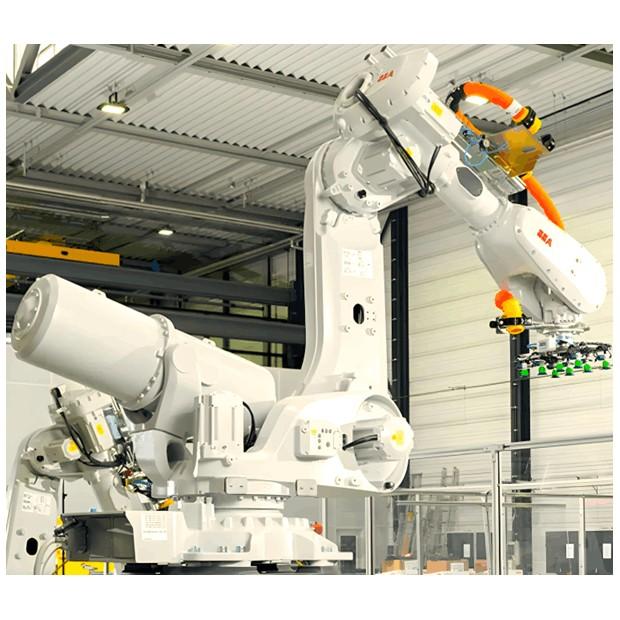Sistem Logistik Gudang Pintar Berdasarkan AGV
Dengan perkembangan pesat industri logistik, kekurangan lahan yang semakin meningkat, dan biaya tenaga kerja yang naik, gudang—sebagai pusat logistik utama—menghadapi tantangan signifikan. Seiring gudang menjadi lebih besar, frekuensi operasional meningkat, kompleksitas informasi bertambah, dan tugas pengambilan pesanan menjadi lebih menantang, mencapai tingkat kesalahan yang rendah dan mengurangi biaya tenaga kerja sambil meningkatkan efisiensi penyimpanan secara keseluruhan telah menjadi tujuan utama bagi sektor pergudangan, mendorong perusahaan menuju otomatisasi pintar.
Makalah ini fokus pada sistem logistik gudang pintar berbasis AGV. Sistem ini menggunakan Kendaraan Panduan Otomatis (AGVs) sebagai pengangkut, terhubung dengan sistem informasi eksternal untuk menerima pesanan, dan menggunakan algoritma perencanaan pintar untuk mengoptimalkan rute AGV. Ini memungkinkan AGVs untuk secara otomatis melakukan tugas seperti penerimaan, pengangkutan, penyimpanan, dan pengiriman barang, sehingga meningkatkan efisiensi dan akurasi sistem logistik sambil mengurangi biaya operasional.
1. Analisis Sistem
Inti dari sistem gudang pintar terletak pada manajemen dan penjadwalan. Sistem yang dijelaskan di sini mengadopsi arsitektur berlapis, dengan data mengalir secara bertahap dari input hingga kontainer penyimpanan hingga AGVs. Berdasarkan persyaratan fungsional dan analisis operasi penyimpanan, sistem dibagi menjadi modul-modul kunci: manajemen gudang, manajemen stasiun, manajemen kendaraan, manajemen pesanan, dan manajemen pengguna.
Manajemen Gudang: Modul ini menangani pemodelan peta gudang dan manajemen informasi. Gudang dibagi menjadi 20 baris dan 12 kolom di tiga tingkat (atas, tengah, bawah). Setiap kontainer memiliki ID unik. Peta termasuk dinding, pintu, dua platform sementara, dan stasiun pengisian daya. Informasi item disimpan berdasarkan lokasi kontainer, dengan data terhubung ke basis data melalui ID kontainer.
Manajemen Stasiun: Lokasi-lokasi penting—seperti pintu masuk gudang, pintu masuk lorong, posisi tiang, stasiun pengisian daya, titik pemuatan/bongkar, dan tempat parkir—didefinisikan sebagai titik awal atau target AGV.
Manajemen Jalur: Jalur menghubungkan stasiun. AGVs mengikuti rute yang telah direncanakan, yang dapat bersifat satu arah atau dua arah, dan linear atau melengkung.
Manajemen Rak: Rak hanya ditempatkan di lokasi rak yang ditentukan. Manajemen rak mendukung operasi AGV untuk memindahkan rak antara titik pemuatan, titik bongkar, dan lokasi rak. Rak memiliki empat status: awal, menunggu pengambilan, dalam transit, dan dikembalikan.
Manajemen Kendaraan: Mengingat setup gudang yang sederhana, hanya satu AGV digunakan, menangani satu kontainer per tugas. Status AGV termasuk: siaga (diam di pintu masuk dengan daya cukup), pengisian daya (bergerak ke charger ketika daya rendah), dan pelaksanaan tugas (secara aktif mengangkut kontainer).
Manajemen Pengisian Daya: Ketika level baterai rendah, AGV secara otomatis meminta pengisian. Sistem menetapkan jalur pengisian, mengunci stasiun pengisian, dan menempatkan AGV dalam mode pengisian, selama ini tidak ada tugas baru yang diberikan hingga baterai mencapai level yang ditentukan.
Manajemen Pengecualian: Anomali potensial AGV termasuk menyimpang dari rute yang direncanakan, gagal meminta pengisian ketika daya rendah, atau kehilangan kendali. Semua pengecualian dicatat, dan jika jumlah anomali melebihi ambang batas yang ditetapkan, peringatan dipicu, menunjukkan perlunya perawatan.
Manajemen Tugas: Tugas baru ditugaskan menggunakan algoritma perencanaan jalur yang telah ditentukan. Setelah inisiasi tugas, sistem menugaskan AGV dan mentransmisikan rute lengkap. Tugas dapat dilihat, dibatalkan, dijeda, atau dimodifikasi. Tugas dikategorikan menjadi tiga jenis: keluar, masuk, dan relokasi.
Manajemen Pengguna: Modul ini mengelola akun dan izin pengguna. Pengguna diklasifikasikan menjadi empat tingkatan: tamu, operator, administrator, dan super administrator, masing-masing dengan hak akses yang berbeda.

2. Tinjauan Desain Sistem
2.1 Prinsip Desain
Visibilitas: Antarmuka pengguna yang ramah digunakan untuk akses dan manajemen data yang intuitif.
Kinerja Real-time: Peta gudang harus mencerminkan posisi, status, dan informasi rak AGV secara real-time dengan penundaan minimal, memastikan komunikasi yang andal.
Stabilitas: Sistem harus tetap stabil di bawah beban data tinggi dan selama operasi jangka panjang.
Skalabilitas: Desain modular memungkinkan ekspansi masa depan dan integrasi fitur baru.
2.2 Arsitektur Sistem
Sistem terdiri dari tiga lapisan:
Lapisan Eksekusi (Transportasi AGV): Operasi fisik AGV.
Lapisan Layanan: Berfungsi sebagai jembatan antara lapisan aplikasi dan eksekusi, termasuk sistem manajemen pusat dan sistem akses. Ini berkomunikasi dengan AGVs, mengumpulkan data status, dan menyediakan API untuk penugasan dan kontrol tugas.
Lapisan Aplikasi: Lapisan atas, berinteraksi langsung dengan pengguna melalui antarmuka berbasis Unity3D. Pengguna mengirim permintaan, dan hasil ditampilkan setelah diproses di backend.
2.3 Desain Basis Data
Data kunci termasuk:
Data pengguna: Informasi dasar dan izin akses.
Data kendaraan: Status AGV, catatan pengisian/daya, dan catatan anomali.
Data tugas: Detail tugas dan status pelaksanaan.
Data gudang: Tata letak, rak, stasiun, titik pengisian, dll., membentuk peta gudang.
Hubungan kunci: pengguna membuat tugas, AGVs mengeksekusi tugas, AGVs beroperasi dalam gudang, dan pengguna mengelola gudang.
2.4 Desain dan Implementasi Sistem Rinci
2.4.1 Implementasi Kerangka Dasar
Proyek Unity3D baru dibuat, mengimpor model 3D untuk mensimulasikan lingkungan gudang. Logika diimplementasikan menggunakan C#.
Login Pengguna:
Pengguna harus otentikasi dan mendapatkan izin berbasis peran sebelum mengakses sistem.
Implementasi Manajemen Gudang:
Fungsi inti termasuk pemodelan gudang, memungkinkan pengguna untuk melihat dan mengedit tata letak kontainer, lokasi kendaraan, dan distribusi rak. Sistem mencakup daftar jalur dan stasiun, dengan manajemen kendaraan mencakup pengisian daya dan penanganan anomali.
2.4.2 Metodologi Desain Peta
Metode pemetaan robotik umum termasuk:
Peta Metrik: Rekonstruksi 2D/3D ruang nyata.
Representasi Langsung: Menggunakan data sensor mentah tanpa diskritisasi.
Peta Grid: Membagi ruang menjadi sel-sel seragam, mudah dikonversi ke graf topologi.
Peta Topologi: Menyajikan lokasi kunci sebagai node, terhubung oleh tepi.
Sistem Koordinat:
Koordinat Tata Letak: Posisi antarmuka virtual di Unity.
Koordinat Model: Posisi dunia nyata (x, y, z). Karena koordinat tata letak dihasilkan secara otomatis, koordinat model harus didefinisikan secara eksplisit untuk simulasi yang realistis.
Jenis Titik dan Operasi:
Titik mewakili posisi AGV (default: 0,0,0). Jenis termasuk: normal, pemuatan/bongkar, masuk/keluar, rak, dan titik pengisian. Titik normal tidak dapat menampung rak atau memungkinkan AGV berhenti dalam jangka waktu lama.
3. Kesimpulan
Dengan kemajuan cepat teknologi logistik pintar dan IoT, gudang sedang beralih dari "mekanisasi manual" ke operasi otomatis "barang ke orang". Operator sekarang dapat memantau inventaris secara real-time, meningkatkan akurasi pemindaian, penyimpanan dinamis, dan efisiensi operasional sambil mengurangi pemborosan dan biaya tenaga kerja.
Namun, seiring sistem cerdas berkembang dan armada AGV bertambah, tantangan dalam alokasi tugas dan kontrol armada tetap ada. Makalah ini menyajikan sistem penjadwalan gudang pintar berbasis AGV yang praktis, menggeser manajemen gudang dari pelacakan inventaris tradisional ke kontrol operasional real-time. Dengan memanfaatkan teknologi sepenuhnya otomatis, sistem memungkinkan operasi masuk dan keluar yang otonom, mendorong transformasi dari otomatisasi ke logistik pintar.























